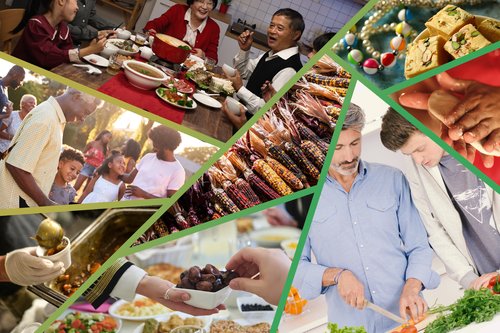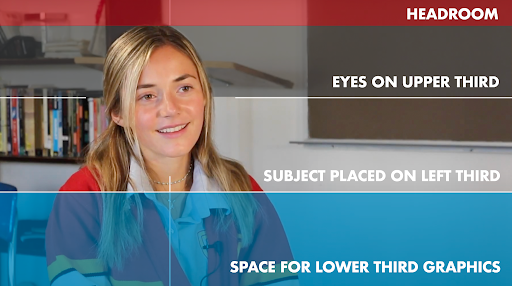
Food brings people together. Every day, all over the world, people sit down and share meals with each other. Student Reporting Labs wants you to explore the food traditions in your life.
How does what you eat shape who you are?
What kinds of dishes do you enjoy with your family and friends? How do these foods and recipes tell a story about you, your family, your culture, and your community?
Here’s a playlist of what stories have been produced from this prompt.
For this project, your challenge is to produce a FEATURE STORY about how food connects to family, culture, and community. Think about the meals you love– holidays, traditions, restaurants, people and their stories. Think about the process of making or eating a favorite recipe and sharing it with people you care about
INSPIRATION: A menu of options to think about:
As you think about how to make your own story, try to keep young people front and center, and the food as secondary (although your broll should be beautiful enough to make the audience hungry!).
Short social media video (TikTok, YouTube shorts, IG reels ect. 60-90 seconds): Use your creativity, have fun, and tell a story about food, culture, and identity. Check out SRL’s social media video guidelines.
Profile (2-4 min long): The story of one person. It has voiceover (VO), b-roll, pictures, nats (natural sound), interviews of family members or peers of that one person.
News package (3-5 min long): Video stories about newsworthy issues and topics, factual information, balanced reporting, research, voice overs, soundbites, b-roll footage, infographics, reporter standup, nats (natural sound bites).
NAT package (2-4 min long): A video story guided by the natural sound from interviews and the environment. Natural sound, commonly known as “NAT sound,” puts the viewer in the place the story was told by enhancing the scene(s) with video containing rich audio such as a musician singing at a train station, a storm approaching, or the sound of a tractor plowing the field. This kind of story would often not have a voiceover narration.
No matter which format you choose, b-roll is going to be very important! A good profile, short social media video, news package or NAT package could be taken to the next level with some great b-roll! Here’s more advice on using your phone to film broll.
Use b-roll as the VISUAL REPRESENTATION of the story. If you are interviewing someone, listen closely, make notes, and then record video of the actions, objects, and places described during the interview. Especially for this project, strong b-roll will help communicate the story of the artwork or artist you choose.
THINK CRITICALLY
FIND YOUR STORY
Use this storytelling roadmap to complete your story. Use it as both a guide and a checklist.
Look at the image below. Typically, video journalists frame their interview subjects to follow the rule of thirds. When composing a shot for most types of recorded interviews, imagine there’s a Tic-Tac-Toe grid over the screen. Make sure the main action, or the subject's eye, is positioned at one of the intersecting points. Typically the subject looks at the interviewer NOT at the camera. You can also flip the side of the frame for stories with multiple interviews.

ACTIVITY OVERVIEW:
Students will participate in a role-play debate, taking on the perspectives of different stakeholders in the world of food. Each role represents a unique voice in the conversation about culinary tradition and innovation.
Possible Roles:
PURPOSE:
This simulation gives students a creative way to practice research, communication, and collaboration—especially if they’re still building confidence in real-world interviews. It’s a fun and realistic bridge from fiction to authentic storytelling.
Instructions:
Discussion Questions:
ACTIVITY OVERVIEW:
Students will become culinary innovators, tasked with creating a fusion dish that combines local and global flavors. This hands-on challenge encourages creativity, teamwork, and cultural curiosity.
STEPS:
Discussion Questions:
Production and Submission Steps
Story Planning:
Video Production:
Editing:
Ethical journalism strives to ensure the free exchange of information that is accurate, fair and thorough. An ethical journalist acts with integrity. Ethical journalism should be accurate and fair. Journalists should be honest and courageous in gathering, reporting and interpreting information.
Media refers to all electronic or digital means and print or artistic visuals used to transmit messages.
All forms of media created with the purpose of informing the public and delivering news through specific mediums such as radio and broadcast stations, digital news organizations and others.
The act of consuming any form of media including anything that is text or visual. It can be books, television, papers, flyers, advertisements, newspapers, information on the Internet, etc.
A subject or problem that people are thinking and talking about
A group of people who live in the same area (such as a city, town, or neighborhood). It can also be a group of people who have the same interests, religion, race, etc.
People are interested in other people. Everyone has something to celebrate and something to complain about. We like unusual stories of people who accomplish amazing feats or handle a life crisis because we can identify with them.
An account of past or current events. In journalism, stories are presented with a combination of people, facts, and typically includes a beginning, middle and end.
A person or other physical being in a narrative. Stories are made up of different characters who provide information and help shape the narrative with their knowledge, experience and perspective.
Video stories about newsworthy issues and topics, factual information, balanced reporting, research, voice overs, soundbites, b-roll footage, infographics, reporter standup, nats (natural sound bites).
The story of one person, has voiceover (VO), b-roll, pictures, nats (natural sound), interviews of family members or peers of that one person.
Narration and/or voiceover (VO) with a host, commentary, research, personal experiences, explanations, infographics, nats (natural sound), music, entertainment.
Narration and/or voiceover (VO), scene reconstructions, archival footage, nats (natural sound), b-roll, images, research, lengthy interviews, soundbites.
A short video clip that captures the interview subject in their natural state. It involves a person looking into the lens for a few seconds. It’s like a still photo but video!
A person who gives an account or tells the story of events, experiences, etc. In news, it is the person who adds spoken commentary to the video news story.
A desire to learn and know about something or anything.
The supplemental footage used to visually support your A-ROLL.
Search: broll.
Historical understanding requires recognizing this multiplicity of points of view in the past, which makes it important to seek out a range of sources on any historical question rather than simply use those that are easiest to find. It also requires recognizing that perspectives change over time, so that historical understanding requires developing a sense of empathy with people in the past whose perspectives might be very different from those of today. (NCSS D2.His.4.9-12 - D2.His.8.9-12)
Journalism
Representation
History
Arts
Identity
Social Media
Intermediate
Mic
Camera
Mobile Phone
Internet
4-6 weeks